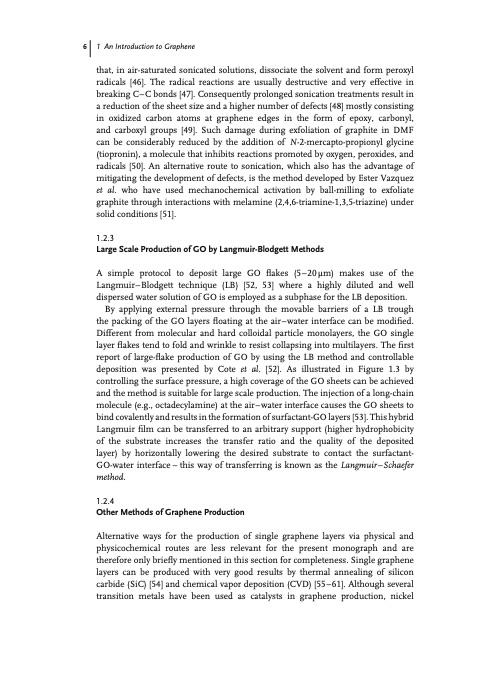
PDF Publication Title:
Text from PDF Page: 006
6 1 An Introduction to Graphene that, in air-saturated sonicated solutions, dissociate the solvent and form peroxyl radicals [46]. The radical reactions are usually destructive and very effective in breaking C–C bonds [47]. Consequently prolonged sonication treatments result in a reduction of the sheet size and a higher number of defects [48] mostly consisting in oxidized carbon atoms at graphene edges in the form of epoxy, carbonyl, and carboxyl groups [49]. Such damage during exfoliation of graphite in DMF can be considerably reduced by the addition of N-2-mercapto-propionyl glycine (tiopronin), a molecule that inhibits reactions promoted by oxygen, peroxides, and radicals [50]. An alternative route to sonication, which also has the advantage of mitigating the development of defects, is the method developed by Ester Vazquez et al. who have used mechanochemical activation by ball-milling to exfoliate graphite through interactions with melamine (2,4,6-triamine-1,3,5-triazine) under solid conditions [51]. 1.2.3 Large Scale Production of GO by Langmuir-Blodgett Methods A simple protocol to deposit large GO flakes (5–20μm) makes use of the Langmuir–Blodgett technique (LB) [52, 53] where a highly diluted and well dispersed water solution of GO is employed as a subphase for the LB deposition. By applying external pressure through the movable barriers of a LB trough the packing of the GO layers floating at the air–water interface can be modified. Different from molecular and hard colloidal particle monolayers, the GO single layer flakes tend to fold and wrinkle to resist collapsing into multilayers. The first report of large-flake production of GO by using the LB method and controllable deposition was presented by Cote et al. [52]. As illustrated in Figure 1.3 by controlling the surface pressure, a high coverage of the GO sheets can be achieved and the method is suitable for large scale production. The injection of a long-chain molecule (e.g., octadecylamine) at the air–water interface causes the GO sheets to bind covalently and results in the formation of surfactant-GO layers [53]. This hybrid Langmuir film can be transferred to an arbitrary support (higher hydrophobicity of the substrate increases the transfer ratio and the quality of the deposited layer) by horizontally lowering the desired substrate to contact the surfactant- GO-water interface – this way of transferring is known as the Langmuir–Schaefer method. 1.2.4 Other Methods of Graphene Production Alternative ways for the production of single graphene layers via physical and physicochemical routes are less relevant for the present monograph and are therefore only briefly mentioned in this section for completeness. Single graphene layers can be produced with very good results by thermal annealing of silicon carbide (SiC) [54] and chemical vapor deposition (CVD) [55–61]. Although several transition metals have been used as catalysts in graphene production, nickelPDF Image | An Introduction to Graphene

PDF Search Title:
An Introduction to GrapheneOriginal File Name Searched:
352733551X-c01.pdfDIY PDF Search: Google It | Yahoo | Bing
Salgenx Redox Flow Battery Technology: Power up your energy storage game with Salgenx Salt Water Battery. With its advanced technology, the flow battery provides reliable, scalable, and sustainable energy storage for utility-scale projects. Upgrade to a Salgenx flow battery today and take control of your energy future.
| CONTACT TEL: 608-238-6001 Email: greg@infinityturbine.com | RSS | AMP |